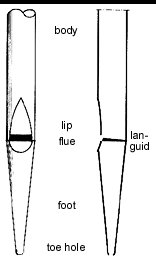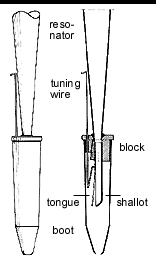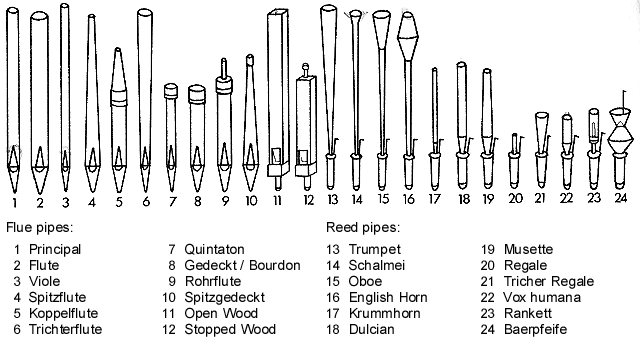
| Please note that the diagrams on this page are scans taken from the book "Die Orgel" by Friedrich Jacob
(Schott Verlag), textual comments on the diagrams are mine. Pictures of the flues and reeds can be enlarged
by clicking on them. The sound samples of the organ stops are taken from the CD "Das Geheimnis Orgel", played by Paul Wißkirchen at the Altenberg Cathedral Organ with kind permission of TMK-Group Media Production & Marketing (Cologne). |
| The basic types of pipes
The timbre and volume of the sound a pipe will produce depend on its type and its shape. There are two basic types of organ pipes that produce the sound in different ways, flue pipes and reed pipes. |
|||
 |
Flue pipes (also called labial pipes) consist of a body that comes in different shapes and a foot through which the air is blown in. Between them is the languid with a narrow gap called the mouth. Here the air blown into the pipe will be swirled around which will cause the air column above to vibrate. The number of vibrations and thus the frequency (i.e. the pitch of the sound produced) is determined by the length of the air column, that is, the length of the pipe body. The length of the foot does not have any impact on the pitch (for more information on pipe length and pitch click here. Not only the material and the shape of the flue pipe have an impact on its sound and volume. These are also influenced by the diameter of the pipe, the size of the lip, the position of the mouth in the pipe and, of course, the pressure with which the air is blown in. Flue pipes are categorized according to their shape (e.g. open or stopped), their material (metal in different alloys or wood) and their diameter, the scale. Categories for scale include: |
||
| • broad scale: flutes = soft, full-bodied, warm sound |  |
Sound sample: flutes 16' + 8' + 4' | |
| • medium scale: principals = clear, somewhat stronger sound |  |
Sound sample: principals 16' + 8' + 4' | |
| • narrow scale: strings = sharp but weaker sound |  |
Sound sample: strings 16' + 8' + 4' | |
| Of course this is only a rough division, there do exist mixtures and mutations as well. Consequently the choice of the scale always depends on the size of the room that the sound of the organ has to fill, too. | |||
 |
In reed pipes (also called lingual pipes), on the other hand, what is important happens in the foot. When the air is blown into the pipe it first hits a metal tongue resting against a hole in the side of the shallot, keeping a little distance from it and fixed to it at ist upper ending. All this is drilled into the block and connected to a flared pipe, the resonator. Now if the tongue vibrates between its resting position and the hole in the shallot it produces a buzzing sound very much different from the sound of a flue pipe. Depending on the shape and length of the resonator |
||
| the sound produced can vary as far as being like a soft whisper or a bold tuba sound. |
 |
Sound sample: two different trumpet batteries 16' + 8' + 4' | |
In reed pipes, as opposed to flue pipes, the length of the resonator does not determine the pitch but together with its shape it determines the timbre. You can shorten the resonator almost as much as you like, the sound will only get weaker but the pitch will not change as it depends only on the length of the vibrating tongue. This obviously applies vice versa as well. The longer the resonator the bolder and more penetrating the sound produced. Of course the volume – and in this reed pipes do resemble flue pipes – depends on the air pressure as well. The higher the air pressure the louder the sound. Reed pipes are tuned with the tuning wire that controls how much of the tongue is allowed to vibrate. As the tongue in a reed pipe is much shorter than a flue pipe producing the same pitch reed pipes tend to go out of tune more easily and are more affected by changes in temperature. In order to make tuning easier and quicker the tuning wire is made to stick out of the block so that you can simply raise or lower it to adjust the pitch. |
|||
| Pipe shapes and families
When an organ is described all stops are usually listed in a so-called stoplist / disposition. A set of pipes consists of as many single pipes as there are keys on the manual. Each key is connected to a corresponding pipe of corresponding length (pitch). These sets of pipes are called stop / voice / register (sometimes "stops" also means couplers or tremulants, not only real pipe voices / registers - that's why I prefer using "voices" in the totals). Looking at the name of the stop you can tell what kind of pipes these are and what kind of a sound they produce. In a Mixture each key on the keyboard is connected to several pipes of different pitch (in general the set of overtones to the basic tone so that you get a lighter or modified tone sound). This way one stop may include more than one set of pipes (ranks). Something rather peculiar is the Vox Celeste where a regular stop is played together with a slightly detuned one. Such "detuned" stops are called for instance Vox Celeste, Voix céleste, Celeste, Unda Maris or, in German organs, Schwebung (for a sound sample see below on the right side). |
|||
The most common organ stops and pipe shapes are shown below: |
And here you find some sound samples of these stops: |
||
 |
Principal 16' + 8' + 4' | ||
 |
Principal Pleno with Mixture | ||
 |
Flutes 8' + 4' | ||
 |
Cornet (Flutes / Gedeckts 8' + 4' + 2 2/3' + 2' + 1 3/5') | ||
 |
Viols 16' + 8' + 4' | ||
 |
Salicional (narrow Viol) with Vox Celeste | ||
 |
Trumpet 8' (German style) | ||
 |
Trompette 8' (French style) | ||
 |
Spanish (Horizontal-) Trumpet 8' | ||
 |
Bombarde 16' (French bass trumpet in the manual) | ||
 |
Grands Jeux (= great reed choir, poss. with Cornet) | ||
 |
Trombone 16' (strong bass trumpet in the pedal) | ||
 |
Contra-Trombone 32' | ||
 |
Oboe 8' | ||
 |
Krummhorn 8' | ||
 |
Dulcian 16' | ||
 |
Orlos 8' (horizontal Regal) | ||
 |
Vox humana 8' (with tremulant; explanation here) | ||
| Direct links to other parts of The Organ Site: • Sound samples played by myself • Pipe length and pitch • Dictionary of organ stops in ten languages • Joke stoplist – the dream (?) of every organist :-) |
| Voicing Even if two stops have identical names this does not mean that their sound is identical as well. The reason for this is that their "voicing", i.e. their scaling (cf. above) and the exact shape of the pipes, may differ ( e.g. on which level you have the flue, different shapes of the labia, different wind pressures (see function), materials, etc.). Voicing is the art of arranging the stops in a way that they yield an optimal sound in the acoustic conditions of the church building where they are installed, and this not only when they are played by themselves but also when they are being combined with other stops. Also, in large organs where you have the same stop several times over you can voice each stop differently so that you have more sound variation. You can hear this quite well in the sound samples of the different trumpet stops above. Read more about the art of voicing on voicing specialist Reiner Janke's homepage. |
